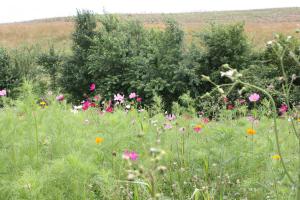The Importance of Pollinators
In the United States one third of all agricultural output depends on pollinators. Fruit and vegetable growers in Pennsylvania can attest to the significant role pollinators play in the production of many of our crops.
The Importance of Pollinators
In the United States one third of all agricultural output depends on pollinators. Fruit and vegetable growers in Pennsylvania can attest to the significant role pollinators play in the production of many of our crops. Promoting pollinators' habitat on and near the farm benefits everyone who likes to eat!

Insects and other animal pollinators are vital to the production of healthy crops for food, fibers, edible oils, medicines, and other products. The commodities produced with the help of pollinators generate significant income for producers and those who benefit from a productive agricultural community. Pollinators are also essential components of the habitats and ecosystems that many wild animals rely on for food and shelter.
There is evidence that populations of native and managed pollinators are in decline, and the loss of benefits derived from them is being felt by the agricultural community. Human activity such as urbanization can lead to habitat fragmentation or destruction. Changes in agricultural practices and the use of broad-spectrum pesticides can disrupt or destroy long-established pollinator habitats. Other factors leading to pollinator decline include disease, and the spread of invasive plant species.
Whether you are a farmer or a homeowner, there are many ways you can learn about pollinators and help them to prosper by enhancing native pollinator habitats and protecting against pollinator declines.
Did You Know?
- Pollinators support biodiversity: There is a correlation between plant diversity and pollinator diversity.
- The pollinator population of an area is a great indicator of the overall health of an ecosystem.
- Some crops, including blueberries and cherries, are 90 percent dependent on honey bee pollination.
- Honey bees visit five million flowers to make one pint of honey.
- To produce 150 pounds of honey, bees cover a distance equal to 13 trips to the moon and back.
- 90 percent of the nation's apple crop is pollinated by bees.
- Bees tend to prefer flowers that they can walk on to sip nectar. Butterflies and moths need a place to land on the flowers that they visit, so they prefer broad, flat-faced flowers.
- There are 4000 bee species in the U.S. There are 450 species in New York State alone. *More than 300 species occur in Pennsylvania.
- Increased yields and higher quality crops are benefits that growers and consumers realize from a healthy pollinator population, native or managed.
- Worldwide, approximately 1,000 plants grown for food, beverages, fibers, spices, and medicines need to be pollinated by animals in order to produce the goods on which we depend.
- It’s estimated that there are about 2.4 million bee colonies in the U.S. today, two-thirds of which travel the country each year pollinating crops and producing honey and beeswax.
- Flowers bloom during the day and night, depending on which pollinator they need to attract. Day-blooming flowers are often brightly colored, while those that bloom at night are often pale, and may produce sweet scents or odors to attract nocturnal pollinators such as moths and bats.
Tips for Establishing a Healthy Pollinator Habitat
- Start right. Flowering plants can be started from seed; shrubs are better established by transplanting seedlings.
- Consider the soil characteristics, site drainage, sunlight, and other factors when selecting plants.
- Provide a variety of flower colors and shapes to attract different pollinators.
- Plant in clumps, rather than single plants, to better attract pollinators.
- Choose plants that flower at different times of the year to provide nectar and pollen sources throughout the growing season.
- Whenever possible, choose native plants. These plants will be better adapted to your soil type, climate, precipitation, and local pollinators.
- Avoid the use of pesticides. Practice Integrated Pest Management (IPM) to reduce damage to your plants and to protect pollinators by using less chemicals.
- Visit a plant nursery to ask about pollinator plants suited for your site conditions.
- Pollinators, need water too. You can provide water for pollinators with a shallow dish, bowl, or birdbath with half-submerged stones for perches.
USDA Works To Increase Pollinator Population
A video describing the importance of native pollinators in Pennsylvania has recently been posted on YouTube. Produced by Penn State’s Dr. Ed Rajotte and Dr. David Biddinger, “Native Pollinators: A Promising Solution to an Emerging Crisis”, describes the decline of honey bees and the role other native pollinators play in pollination of crops. It depicts the efforts of Penn State’s Center for Pollinator Research, NRCS and the Xerces Society in researching the most effective native pollinators and assisting growers by planting pollinator habitats in farms and orchards in Pennsylvania. For more information on pollinators, visit the Center for Pollinator Research at http://ento.psu.edu/pollinators.
Information Resources
The links provided here are excellent starting points for those interested in learning more about pollinators.
- Conservation Work for Monarch Butterflies - Natural Resources Conservation Service (NRCS)
- Celebrating Pollinators - wildflowers, pollinators and posters (USDA Forest Service) Link coming Soon!
-
Natural Resources Conservation Service (NRCS)Farming for Pollinators (1.9 MB)
- Fish and Wildlife Habitat Management Leaflets - NRCS Agricultural Wildlife Conservation Center
- How Farmers Can Help Pollinators - Natural Resources Conservation Service (NRCS) Link coming Soon!
- North American Pollinator Protection Campaign (NPPH)
- Pollinators - NRCS Documents for Pollinator Conservation and Enhancement
- Pollinators - U.S. Fish and Wildlife Service (USFWS)
- The Buzz on Native Pollinators - National Wildlife Federation (NWF)
- Xerces Society for Invertebrate Conservation (Xerces.org)
- Xerces Society Pollinator Resources
- Xerces Society Pollinator Conservation Program - publications, information for agriculture, gardening, parks, golf courses, and more
- Fact Sheets for Landowners and Growers from Xerces
- Pollinators National Web Site
-
Native Bee Benefits Fact Sheet (1.31 MB)

